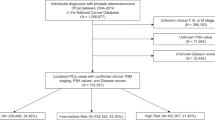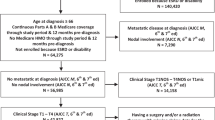Abstract
Background:
To evaluate the relationship between PSA testing history and high-risk disease among older men diagnosed with prostate cancer.
Methods:
Records from 1993 to 2014 were reviewed for men who underwent radiotherapy for prostate cancer at age 75 years or older. Patients were classified into one of four groups based on PSA-testing history: (1) no PSA testing; (2) incomplete/ineffective PSA testing; (3) PSA testing; or (4) cannot be determined. Outcomes of interest were National Comprehensive Cancer Network (NCCN) risk group (that is, low, intermediate or high risk) and biopsy grade at diagnosis. Multivariable logistic regression was used to determine the association between PSA testing history and high-risk cancer.
Results:
PSA-testing history was available in 274 (94.5%) of 290 subjects meeting study criteria. In total, 148 men (54.0%) underwent PSA testing with follow-up biopsy, 72 (26.3%) underwent PSA testing without appropriate follow-up, and 54 men (19.7%) did not undergo PSA testing. Patients who underwent PSA testing were significantly less likely to be diagnosed with NCCN high-risk cancer (23.0% vs 51.6%, P<0.001). On multivariable analysis, men with no/incomplete PSA testing had more than three-fold increased odds of high-risk disease at diagnosis (odds ratio 3.39, 95% confidence interval 1.96–5.87, P<0.001) as compared to the tested population.
Conclusions:
Older men who underwent no PSA testing or incomplete testing were significantly more likely to be diagnosed with high-risk prostate cancer than those who were previously screened. It is reasonable to consider screening in healthy older men likely to benefit from early detection and treatment.
This is a preview of subscription content, access via your institution
Access options
Subscribe to this journal
Receive 4 print issues and online access
$259.00 per year
only $64.75 per issue
Buy this article
- Purchase on Springer Link
- Instant access to full article PDF
Prices may be subject to local taxes which are calculated during checkout
Similar content being viewed by others
References
Siegel RL, Miller KD, Jemal A . Cancer statistics. CA Cancer J Clin 2015; 65: 5–29.
Schröder FH, Hugosson J, Roobol MJ, Tammela TLJ, Zappa M, Nelen V et al. Screening and prostate cancer mortality: Results of the European Randomised Study of Screening for Prostate Cancer (ERSPC) at 13 years of follow-up. Lancet 2014; 6736: 1–9.
Loeb S, Vellekoop A, Ahmed HU, Catto J, Emberton M, Nam R et al. Systematic review of complications of prostate biopsy. Eur Urol 2013; 64: 876–892.
U.S. Preventive Services Task Force. Screening for prostate cancer: U.S. Preventive Services Task Force recommendation statement. Ann Intern Med 2008; 149: 185–191.
Scosyrev E, Messing EM, Mohile S, Golijanin D, Wu G . Prostate cancer in the elderly. Cancer 2012; 118: 3062–3070.
Bekelman JE, Mitra N, Handorf EA, Uzzo RG, Hahn SA, Polsky D et al. Effectiveness of androgen-deprivation therapy and radiotherapy for older men with locally advanced prostate cancer. J Clin Oncol 2015; 33: 716–722.
Bechis SK, Carroll PR, Cooperberg MR . Impact of age at diagnosis on prostate cancer treatment and survival. J Clin Oncol 2011; 29: 235–241.
Richstone L, Bianco FJ, Shah HH, Kattan MW, Eastham JA, Scardino PT et al. Radical prostatectomy in men aged ⩾70 years: effect of age on upgrading, upstaging, and the accuracy of a preoperative nomogram. BJU Int 2008; 101: 541–546.
Konety BR, Cowan JE, Carroll PR . Patterns of primary and secondary therapy for prostate cancer in elderly men: analysis of data from CaPSURE. J Urol 2008; 179: 1797–1803.
Ketchandji M, Kuo Y-F, Shahinian VB, Goodwin JS . Cause of death in older men after the diagnosis of prostate cancer. J Am Geriatr Soc 2009; 57: 24–30.
Repetto L, Balducci L, Yancik R, Ries L, Vecchia C, La, Lucchini F et al. A case for geriatric oncology. Lancet Oncol 2002; 3: 289–297.
Barocas DA, Mallin K, Graves AJ, Penson DF, Palis B, Winchester DP et al. The Effect of the USPSTF Grade D recommendation against screening for prostate cancer on incident prostate cancer diagnoses in the united states. J Urol 2015; 194: 1587–1593.
Mahal BA, Aizer AA, Efstathiou JA, Nguyen PL . Association of very low prostate-specific antigen levels with increased cancer-specific death in men with high-grade prostate cancer. Cancer 2016; 122: 78–83.
Vollmer RT . The dynamics of death in prostate cancer. Am J Clin Pathol 2012; 137: 957–962.
Catalona WJ, Smith DS, Ratliff TL, Dodds KM, Coplen DE, Yuan JJJ et al. Measurement of prostate-specific antigen in serum as a screening test for prostate cancer. N Engl J Med 1991; 324: 1156–1161.
Mohler JL, Armstrong AJ, Bahnson RR, D’Amico AV, Davis BJ, Eastham JA et al. Prostate cancer, Version 1. 2016 J Natl Compr Canc Netw 2016; 14: 19–30.
Epstein JI, Egevad L, Amin MB, Delahunt B, Srigley JR, Humphrey PA . The 2014 international society of urological pathology (ISUP) consensus conference on gleason grading of prostatic carcinoma: definition of grading patterns and proposal for a new grading system. Am J Surg Pathol 2016; 40: 244–252.
Cooperberg MR, Moul JW, Carroll PR . The changing face of prostate cancer. J Clin Oncol 2005; 23: 8146–8151.
Sirovich BE, Schwartz LM, Woloshin S . Screening men for prostate and colorectal cancer in the United States. JAMA 2003; 289: 1414.
Drazer MW, Huo D, Schonberg MA, Razmaria A, Eggener SE . Population-based patterns and predictors of prostate-specific antigen screening among older men in the United States. J Clin Oncol 2011; 29: 1736–1743.
Zeliadt SB, Hoffman RM, Etzioni R, Ginger VAT, Lin DW . What happens after an elevated PSA test: the experience of 13,591 veterans. J Gen Intern Med 2010; 25: 1205–1210.
Mohamed ZK, Dominguez-Escrig J, Vasdev N, Bharathan B, Greene D . The prognostic value of transrectal ultrasound guided biopsy in patients over 70 years old with a prostate specific Antigen (PSA) level≤15 ng/ml and normal digital rectal examination: a 10-year prospective follow-up study of 427 consecutive patients. Urol Oncol 2013; 31: 1489–1496.
Bott SRJ, Foley CL, Bull MD, Reddy CCJ, Freeman A, Montgomery BSI et al. Are prostatic biopsies necessary in men aged > or =80 years? BJU Int 2007; 99: 335–338.
Bill-Axelson A, Holmberg L, Garmo H, Rider JR, Taari K, Busch C et al. Radical prostatectomy or watchful waiting in early prostate cancer. N Engl J Med 2014; 370: 932–942.
Wei JT . Limitations of a contemporary prostate biopsy: The blind march forward. Urol Oncol Semin Orig Investig 2010; 28: 546–549.
Siddiqui MM, Rais-Bahrami S, Turkbey B, George AK, Rothwax J, Shakir N et al. Comparison of MR/ultrasound fusion–guided biopsy with ultrasound-guided biopsy for the diagnosis of prostate cancer. JAMA 2015; 313: 390.
Schaeffer EM, Carter HB, Kettermann A, Loeb S, Ferrucci L, Landis P et al. Prostate specific antigen testing among the elderly-when to stop? J Urol 2009; 181: 1606–1614.
Tosoian JJ, Mamawala M, Epstein JI, Landis P, Wolf S, Trock BJ et al. Intermediate and longer-term outcomes from a prospective active-surveillance program for favorable-risk prostate cancer. J Clin Oncol 2015; 33: 3379–3385.
D’Amico A V . Biochemical outcome after radical prostatectomy, external beam radiation therapy, or interstitial radiation therapy for clinically localized prostate cancer. JAMA 1998; 280: 969.
Rodrigues G, Lukka H, Warde P, Brundage M, Souhami L, Crook J et al. The prostate cancer risk stratification project: database construction and risk stratification outcome analysis. J Natl Compr Canc Netw 2014; 12: 60–69.
Gulati R, Tsodikov A, Etzioni R, Hunter-Merrill R a, Gore JL, Mariotto AB et al. Expected population impacts of discontinued prostate-specific antigen screening. Cancer 2014; 120: 3519–3526.
Author information
Authors and Affiliations
Corresponding author
Ethics declarations
Competing interests
The authors declare no conflict of interest.
Additional information
Supplementary Information accompanies the paper on the Prostate Cancer and Prostatic Diseases website
Rights and permissions
About this article
Cite this article
Tosoian, J., Alam, R., Gergis, C. et al. Unscreened older men diagnosed with prostate cancer are at increased risk of aggressive disease. Prostate Cancer Prostatic Dis 20, 193–196 (2017). https://doi.org/10.1038/pcan.2016.64
Received:
Revised:
Accepted:
Published:
Issue Date:
DOI: https://doi.org/10.1038/pcan.2016.64



